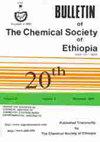Fluoride content of common legume beans consumed in Ethiopia
IF 1.3
4区 化学
Q3 CHEMISTRY, MULTIDISCIPLINARY
引用次数: 0
Abstract
ABSTRACT. The most widely used legume beans food in Ethiopia are fava beans (Vicia faba), green gram (Vigna radiata), white lupin (Lupinus albus), and three types of kidney beans (Phaseolus vulgaris). These legume crops are grown in various regions of Ethiopia and can absorb significant amounts of fluoride from air, water, and soil. This study examined the fluoride content of legume beans collected from four different regions of Ethiopia by ion selective electrode potentiometry. Fluoride concentrations in this study were found to range from 1.9 to 22.8 mg/kg. Fava bean sample from Asella was found to contain higher fluoride (22.8 mg/kg) than in the fava beans from other sites and other beans from any site. Fluoride levels (13.0 mg/kg) in kidney bean from Migira was in the middle of the range while the fluoride levels (2.5 mg/kg) in the white lupin and green gram (1.9 mg/kg) were found in the lower end of the range. This study indicates that daily consumption of 100 g of fava and kidney beans may results in health problem while that of green gram and white lupin are safe for human health (will not exceed 3 mg/day set by Food and Nutrition Board of USA). KEY WORDS: Fava bean, Green gram, Kidney beans, White lupin, Food, Fluoride Bull. Chem. Soc. Ethiop. 2023, 37(6), 1325-1336. DOI: https://dx.doi.org/10.4314/bcse.v37i6.3埃塞俄比亚食用的普通豆豆的氟化物含量
摘要在埃塞俄比亚最广泛使用的豆类食品是蚕豆(Vicia faba),绿克(Vigna radiata),白罗苹(Lupinus albus)和三种芸豆(Phaseolus vulgaris)。这些豆科作物生长在埃塞俄比亚的各个地区,可以从空气、水和土壤中吸收大量的氟化物。本研究采用离子选择电极电位法检测了从埃塞俄比亚四个不同地区收集的豆豆的氟化物含量。本研究发现氟化物浓度在1.9至22.8毫克/公斤之间。发现来自Asella的蚕豆样品的氟化物含量(22.8毫克/公斤)高于来自其他地点的蚕豆和来自任何地点的其他蚕豆。米吉拉芸豆的氟化物含量(13.0毫克/公斤)处于该范围的中间,而白豆和绿豆的氟化物含量(2.5毫克/公斤)和绿豆的氟化物含量(1.9毫克/公斤)处于该范围的低端。本研究表明,每天食用100克蚕豆和芸豆可能会导致健康问题,而食用绿克和白豆对人体健康是安全的(不超过美国食品和营养委员会规定的每天3毫克)。
关键词:蚕豆、绿豆、芸豆、白豆、食品、氟化物;公牛。化学。Soc。中国生物医学工程学报,2017,37(6),1325-1336。DOI: https://dx.doi.org/10.4314/bcse.v37i6.3
本文章由计算机程序翻译,如有差异,请以英文原文为准。
求助全文
约1分钟内获得全文
求助全文
来源期刊
CiteScore
2.20
自引率
8.30%
发文量
113
审稿时长
6-12 weeks
期刊介绍:
The Bulletin of the Chemical Society of Ethiopia (BCSE) is a triannual publication of the Chemical Society of Ethiopia. The BCSE is an open access and peer reviewed journal. The BCSE invites contributions in any field of basic and applied chemistry.

 求助内容:
求助内容: 应助结果提醒方式:
应助结果提醒方式:


